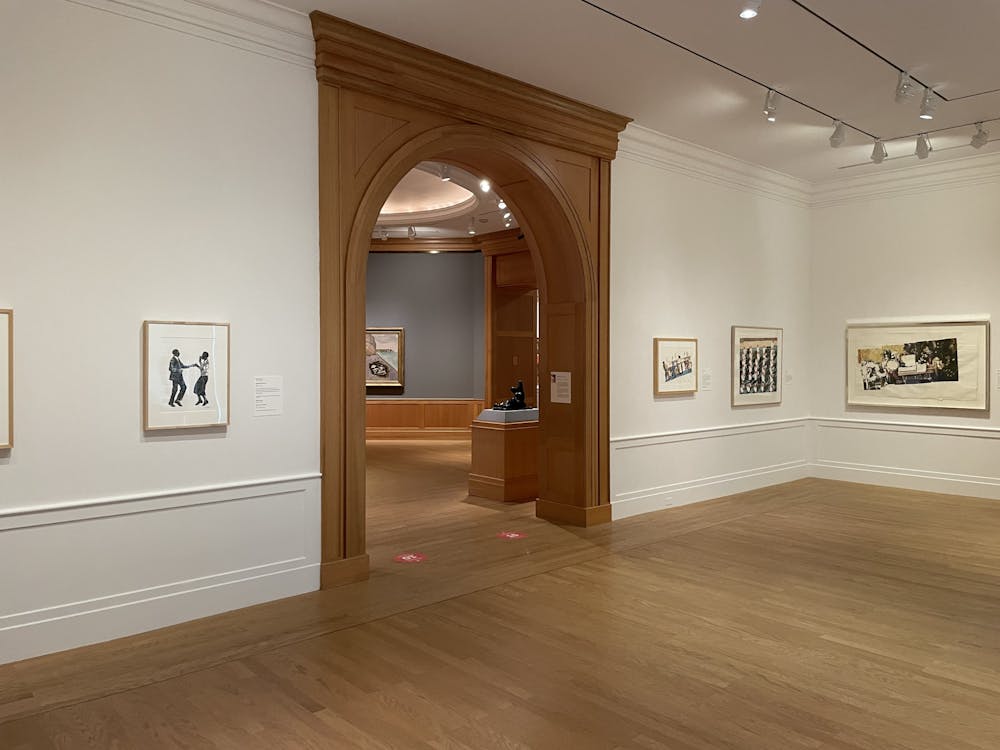If you haven’t yet seen the Richard Yarde exhibit on display at the Baltimore Museum of Art (BMA), you still have a few more weeks to visit. Richard Yarde: Beyond the Savoy will remain on show through April 24, and I urge you to see it while you can. The BMA, which stands adjacent to Homewood Campus, offers free admission and is open Wednesday through Sunday from 10 a.m. to 5 p.m., though entry requires a timed reservation.
Yarde’s oeuvre was first shown at the BMA in 1983. The ongoing exhibition explores his transformation over the past 40 years, incorporating nearly 30 pieces from that span of time. His art celebrates Black history and culture by drawing inspiration from Black photographers and European Post-Impressionists and merging those traditions with his experience growing up in the diverse Boston neighborhood of Roxbury.
In contrast to most watercolor creations, which tend to be small, Yarde’s paintings are large and consume the gallery walls of the BMA. He employs vibrant colors — bright yellows, rich blues, deep reds — to produce a sense of dynamism that characterizes his collection. The figures, though frozen in time, exude a palpable energy; as the viewer, you can feel their movement transcend beyond the frame.
Yarde painted monumental Black figures as his subjects, furthering the esteem he develops for Black culture and history. Some notable portraits on display now include those of Malcolm X and Sojourner Truth, though Yarde also painted everyday individuals like his Roxbury neighbors and even produced a few self-portraits.
My personal favorite piece in the exhibit is Ella Fitzgerald at the Savoy. The Savoy Ballroom, to which the title of the exhibition alludes, is located in Harlem, New York and served as a hub for music and dance. Through rich colors and textured brushwork, Yarde captures the liveliness of the Savoy and honors one of my favorite jazz musicians, Ella Fitzgerald. I also love the bright yellow coloration of The Mirror, a close second favorite.
Yarde’s collection becomes even more impressive in light of his approach to painting. Despite its notoriety as the most unforgiving medium, Yarde skillfully manipulates his watercolor strokes, constructing scenes full of energy. What stands out about Yarde’s method is the fact that he does not rely on any preliminary sketching, opting to paint freehand from start to finish instead. That process leaves no room for error, and Yarde’s admirable ability to craft images on the spot shows through as a result.
Shifting gears, you might as well check out another exhibition while you’re at the BMA anyways. I recommend that you head downstairs to see Matisse: The Sinuous Line, likewise on display through April 24. Henri Matisse’s minimalist work complements Yarde’s dynamic imagery perfectly, providing a comprehensive experience of modern art in a single visit.
Through this collection of small sketches and bronze sculptures, Matisse explores the elegance of the female body. He sketches in pen on paper, effortlessly conveying his subjects and evoking simplicity by using few, thin strokes. His monochrome bronze sculptures, which I personally adore, similarly soften the female body. Capturing its curvature, their reclined and open postures express female sensuality.
Some of the works on display might seem familiar, and for good reason: Fine-line art, influenced by Matisse, has become a popular source of design inspiration for tattoos, dorm tapestries and wallpapers. I myself am attracted to Matisse’s minimalist and abstract depiction of the body; Blue Nude has long served as my iPhone screensaver.
Together, these two exhibits reflect the diversity of modern art in terms of style, medium, subject and more. On one hand, Yarde uses watercolors to paint dynamic subjects that celebrate Black history and culture. On the other hand, Matisse offers a simplified understanding of the female body and its fluidity.
Both of these exhibits, Richard Yarde: Beyond the Savoy and Matisse: The Sinuous Line, are on show until the end of the semester, leaving plenty of time to see them. I encourage you to spend your next Saturday afternoon or a day of spring break at the nearby BMA, reflecting on the themes presented in these collections and the techniques utilized by their respective creators. Visiting the BMA is easy and free; just remember to reserve your ticket in advance!





